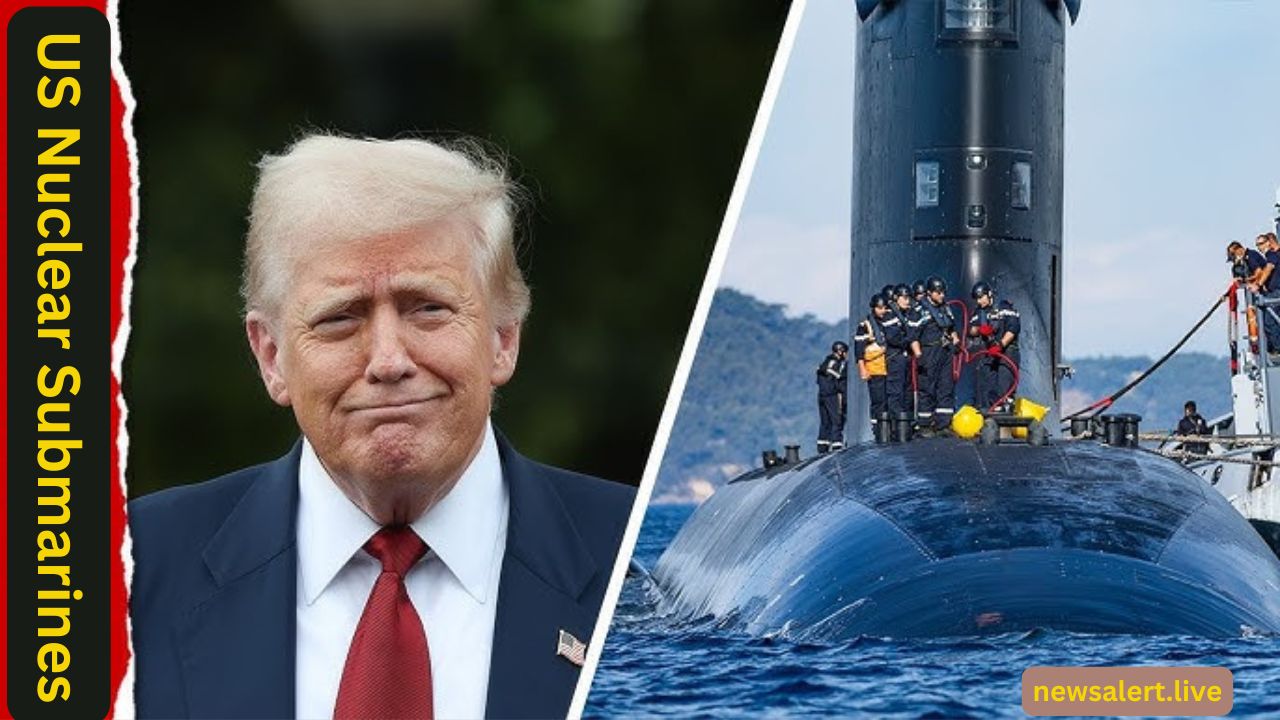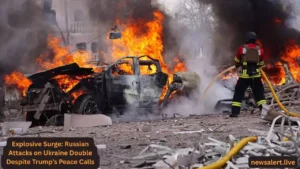President Trump orders the deployment of US nuclear submarines in response to Russia’s threats. What does this mean for global security and the Ukraine conflict?
US Nuclear Submarines Deployed: Trump’s Bold Move Amid Rising Tensions with Russia
In a development that has shaken the geopolitical landscape, President Donald Trump recently announced the deployment of two US nuclear submarines to “appropriate regions.” This decision came in direct response to threats made by former Russian President Dmitri Medvedev following Washington’s ultimatum to Moscow over the ongoing Ukraine crisis. With tensions already at a boiling point, this move has raised serious questions about the possibility of further escalation, the future of the Ukraine conflict, and the broader implications for global security.

The Trigger: Trump’s Response to Medvedev’s Threats
The chain of events began after the White House gave Russia a 10-day deadline to agree to a ceasefire in Ukraine or face tougher sanctions. Dmitri Medvedev responded aggressively, reminding Washington of Russia’s nuclear strike capabilities. This was enough to prompt President Trump to deploy US nuclear submarines, making it clear that America would not tolerate threats or intimidation.
Trump made the announcement on his Truth Social platform, stating:
I am deploying two submarines just in case these foolish and inflammatory statements are more than just that. Words are very important and can often lead to unintended consequences. I hope this will not be one of those instances.
This stern response underscored the seriousness with which the US views Russia’s rhetoric and actions.

Why the Deployment of US Nuclear Submarines Matters
The deployment of US nuclear submarines is far more than symbolic. These submarines form the most discreet and formidable leg of America’s nuclear triad, alongside land-based missiles and strategic bombers. Capable of carrying ballistic missiles with nuclear warheads, they are designed to operate undetected for extended periods, ensuring that the US can respond to any nuclear strike.
Strategic analysts emphasize that this deployment sends a message not only to Russia but also to the entire world: the United States is prepared to use its full range of deterrence capabilities if pushed. This is a high-stakes move that adds another layer of complexity to an already volatile situation.
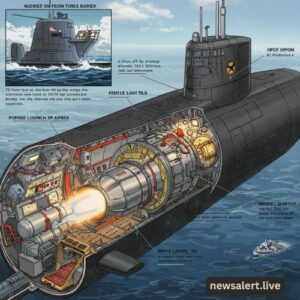
The Historical Context of Nuclear Brinkmanship
This isn’t the first time US nuclear submarines have been at the center of geopolitical tension. During the Cold War, both the US and the Soviet Union relied heavily on nuclear deterrence to avoid direct conflict. The Cuban Missile Crisis in 1962 is perhaps the most famous example of how close the world has come to nuclear war.
Analysts have drawn parallels between Trump’s latest move and his 2017 confrontation with North Korea, where aggressive posturing eventually led to direct negotiations. Could history repeat itself with Russia? Some believe that Trump’s approach is a calculated attempt to force Moscow to the negotiating table, but others warn it could backfire.

Moscow’s Reaction: Silence and Stock Market Shock
Interestingly, the Kremlin has remained publicly silent on Trump’s announcement. Neither President Vladimir Putin nor key Russian ministries have issued formal statements. However, Russia’s stock market told another story, plunging sharply after the news broke.
Russian media outlets expressed surprise at the move, noting that Medvedev’s provocative social media posts—often ignored in the past—have now provoked a significant US response. Some insiders speculate that Moscow is carefully assessing Washington’s intentions before making any public move.

Is Dmitri Medvedev Just a ‘Stalking Horse’?
Former UK Ministry of Defence analyst Professor Paul Morcraft has suggested that Dmitri Medvedev might simply be playing a role designed to stir tensions on behalf of Vladimir Putin.
Medvedev has little real influence,” Morcraft explained. “He is there to be denied if necessary and to shake things up. This allows Putin to stay above the fray while testing Washington’s resolve.
If true, Trump’s decision to deploy US nuclear submarines may have inadvertently elevated Medvedev’s profile while leaving Putin’s strategy unchanged.
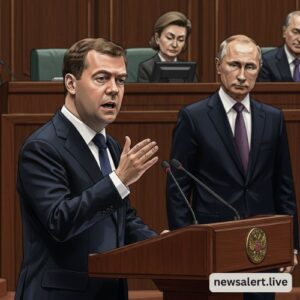
What Does This Mean for the Ukraine War?
The impact of the submarine deployment on the Ukraine conflict remains uncertain. While it undoubtedly raises the stakes, experts caution against assuming that it will lead to meaningful negotiations. Putin has little incentive to change course if Russia is making gains on the battlefield.
Some analysts believe Trump may be laying the groundwork for a high-level meeting with Putin, similar to his previous summits with North Korea’s Kim Jong-un. However, unless Moscow feels genuine pressure, the prospect of a ceasefire remains slim.

Global Reactions and Concerns
The deployment of US nuclear submarines has alarmed America’s NATO allies. European leaders fear that escalating tensions could lead to miscalculation and possibly a broader conflict. Countries like Germany and France are urging restraint, while Eastern European nations closer to Russia are quietly welcoming Washington’s show of force.
China, meanwhile, has issued a cautious statement calling for “dialogue and de-escalation.” Given Beijing’s growing partnership with Moscow, the situation could further complicate global alliances.

Are We on the Brink of a Third World War?
Some commentators argue that the world may be entering the early stages of a new global conflict. Cyberattacks, proxy wars, and aggressive rhetoric have already become commonplace. The deployment of US nuclear submarines adds a dangerous nuclear dimension to this pattern.
Professor Morcraft warns:
This is not the Cuban Missile Crisis yet, but we are symbolically escalating the crisis. Trump is playing a dangerous game of nuclear brinkmanship.

Possible Scenarios Moving Forward
-
De-escalation through Diplomacy: Trump could leverage the deployment to force Putin into direct negotiations, potentially leading to a ceasefire in Ukraine.
-
Continued Stalemate: Moscow might ignore the move, continuing its operations in Ukraine while preparing for fresh sanctions.
-
Escalation: Miscommunication or further provocations could trigger a dangerous cycle of retaliation.
Each of these scenarios carries significant risks and would have a profound impact on global security.
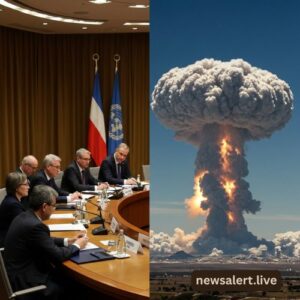
Conclusion
The deployment of US nuclear submarines by President Trump is one of the most significant escalations in US-Russia relations since the Cold War. Whether this bold move will lead to meaningful negotiations or further tension remains uncertain. As the deadline for Russia to agree to a Ukraine ceasefire approaches, the world watches anxiously.
What’s clear is that the stakes have never been higher. The balance between deterrence and provocation is razor-thin, and one misstep could have catastrophic consequences.

FAQs
1. What are US nuclear submarines and why are they important?
US nuclear submarines are advanced vessels capable of carrying ballistic missiles with nuclear warheads. They form a critical part of America’s nuclear deterrent because they can operate undetected, ensuring the US can respond to any attack.
2. Where have the submarines been deployed?
The exact locations are classified. The US never discloses the positions of its nuclear submarines to maintain their deterrent value.
3. Will this deployment lead to a ceasefire in Ukraine?
It’s unclear. While the move might pressure Moscow, Russia’s current battlefield advantage makes it unlikely to halt operations without additional incentives.
4. Could this escalate into a nuclear conflict?
While unlikely, the risk of miscalculation has increased. The presence of US nuclear submarines near Russia sends a powerful message, but it also raises the stakes.
5. How has Russia responded so far?
The Kremlin has remained silent, though its stock market reacted sharply. Experts believe Moscow is carefully assessing Washington’s intentions.

